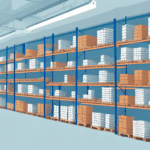Understanding the Cost of Goods Sold (COGS) in E-Commerce
As an e-commerce entrepreneur, understanding the Cost of Goods Sold (COGS) is essential to your success. COGS represents the direct expenses involved in producing and delivering a product to your customers. This article delves into the definition and components of COGS, its significance for e-commerce businesses, calculation methods, common pitfalls, and best practices for effective management.
Breaking Down COGS: Definition and Components
COGS encompasses all the direct costs associated with the production and delivery of goods. This includes the cost of raw materials, labor, shipping fees, and manufacturing expenses. The formula to calculate COGS is:
COGS = Beginning Inventory + Purchases - Ending Inventory
- Beginning Inventory: The value of inventory at the start of the accounting period.
- Purchases: The cost of goods acquired during the accounting period.
- Ending Inventory: The value of inventory remaining at the end of the accounting period.
It's crucial to note that COGS includes only direct expenses and excludes indirect costs like marketing and administrative expenses. Understanding your COGS is vital for assessing profitability, pricing strategies, and inventory management. Regular analysis can help identify cost-saving opportunities and enhance production efficiency.
Importance of COGS for E-Commerce Businesses
COGS is a fundamental metric that directly influences the profitability of e-commerce operations. A high COGS can erode profit margins, making business growth challenging. Conversely, optimizing COGS can enhance profitability and support business expansion.
Impact on Profit Margins
By accurately determining COGS, businesses can set appropriate pricing to ensure profitability. Misjudging COGS may lead to underpricing, making it difficult to cover expenses and earn profits.
Pricing Strategy
Understanding COGS allows businesses to establish competitive pricing while maintaining desired profit margins. It ensures that prices are neither too high to deter customers nor too low to incur losses.
Operational Efficiency
Analyzing COGS helps identify costly materials or processes, enabling businesses to streamline operations and reduce expenses. This leads to more efficient and cost-effective production.
Calculating COGS for Your Online Store
Accurate calculation of COGS is essential for financial planning and strategy. Follow these steps to calculate COGS for your online store:
- Determine Beginning Inventory: Assess the inventory value at the start of the accounting period.
- Add Purchases: Include the cost of inventory acquired during the period.
- Subtract Ending Inventory: Deduct the value of remaining inventory at the end of the period.
Additionally, include all direct costs such as raw materials, labor, and shipping. Utilizing accounting software like QuickBooks can streamline this process and ensure accuracy.
Regularly reviewing your COGS ensures it remains accurate, allowing you to make informed decisions about pricing, inventory management, and cost reduction.
Common Mistakes to Avoid When Calculating COGS
Accurate COGS calculation is critical, yet many e-commerce entrepreneurs make common errors:
- Excluding Direct Expenses: Ensure all direct costs, including packaging and shipping, are accounted for.
- Misclassifying Expenses: Properly categorize expenses as variable or fixed to avoid inaccuracies.
- Inaccurate Inventory Tracking: Maintain precise records of inventory levels to ensure correct COGS calculation.
- Ignoring Lost or Damaged Inventory: Account for inventory losses to prevent distortions in COGS.
- Overlooking Returns: Factor in the cost of returns, as they can significantly impact COGS.
Avoiding these mistakes requires a thorough understanding of your business operations and meticulous record-keeping.
Optimizing COGS for Enhanced Profit Margins
Effective COGS management can significantly boost profit margins. Here are strategies to optimize COGS:
- Invest in Automation: Utilize technology to streamline production and reduce labor costs.
- Negotiate with Suppliers: Secure better pricing on raw materials by building strong supplier relationships.
- Enhance Inventory Management: Implement systems to minimize waste and prevent stockouts, such as TradeGecko.
- Regular Expense Reviews: Continuously assess and cut unnecessary costs without compromising quality.
Implementing these strategies can lead to significant cost reductions and improved profitability.
Reducing COGS: Tips and Tactics for E-Commerce Entrepreneurs
Reducing COGS involves a comprehensive approach aimed at minimizing production costs while maintaining product quality. Consider the following tactics:
- Automation and Technology: Invest in tools that automate repetitive tasks, reducing labor costs and increasing efficiency.
- Supplier Optimization: Seek alternative suppliers or negotiate better terms with existing ones to lower raw material costs.
- Lean Manufacturing: Adopt lean principles to eliminate waste and streamline production processes.
- Efficient Inventory Management: Use demand forecasting and just-in-time inventory systems to reduce holding costs.
Implementing these tactics can lead to sustainable COGS reductions and enhance your competitive edge.
The Relationship Between COGS and Inventory Management
Effective inventory management is intrinsically linked to COGS optimization. Proper management ensures that inventory levels align with demand, reducing excess stock and minimizing holding costs. Key strategies include:
Demand Forecasting
Accurate forecasting helps maintain optimal inventory levels, preventing overstocking and stockouts.
Safety Stock Optimization
Maintaining appropriate safety stock levels ensures product availability without incurring unnecessary holding costs.
Just-In-Time (JIT) Inventory
JIT inventory systems align production schedules with demand, reducing inventory holding costs and minimizing waste.
Tools like Shopify Inventory Management can assist in implementing these strategies effectively.
Real-Life Examples of COGS Optimization in E-Commerce
Several e-commerce giants have successfully optimized their COGS to enhance profitability:
- Amazon: Utilizes its extensive supply chain network to negotiate favorable prices with suppliers, reducing COGS and enabling competitive pricing.
- Nordstrom: Implements a just-in-time inventory management system to minimize holding costs and prevent stockouts.
- Warby Parker: Invests in automation and technology to streamline production, reducing labor costs and increasing efficiency.
These examples demonstrate the effectiveness of strategic COGS optimization in driving business success.
Future Trends in COGS Management for E-Commerce
The landscape of COGS management is evolving with advancements in technology and changing market dynamics. Anticipate the following trends:
- Increased Automation: Greater adoption of automation technologies to further streamline production processes and reduce labor costs.
- Advanced Analytics: Leveraging big data and analytics to gain deeper insights into cost drivers and optimize COGS.
- Sustainable Practices: Incorporating sustainable materials and processes to not only reduce costs but also appeal to environmentally conscious consumers.
- Global Sourcing: Expanding supplier networks globally to access cost-effective materials and mitigate supply chain risks.
Staying abreast of these trends will enable e-commerce businesses to maintain a competitive edge and effectively manage their COGS.
Best Practices for Monitoring and Analyzing COGS Data
Effective monitoring and analysis of COGS data are critical for informed decision-making. Implement the following best practices:
- Utilize Specialized Software: Use accounting tools like Xero or Sage 50cloud to maintain accurate records of expenses and inventory levels.
- Regular Data Review: Conduct periodic reviews of COGS data to identify trends, anomalies, and opportunities for cost reduction.
- Benchmarking: Compare your COGS against industry standards to gauge performance and identify areas for improvement.
- Informed Pricing Strategies: Use COGS data to set prices that cover costs and achieve desired profit margins.
Adopting these practices ensures that your COGS data is accurate, actionable, and aligned with your business goals.
Conclusion
Understanding and effectively managing the Cost of Goods Sold (COGS) is pivotal for e-commerce entrepreneurs aiming to optimize production processes, set competitive pricing, and maximize profitability. By accurately calculating, monitoring, and analyzing COGS, businesses can make informed decisions that drive long-term success in the competitive e-commerce landscape.




















